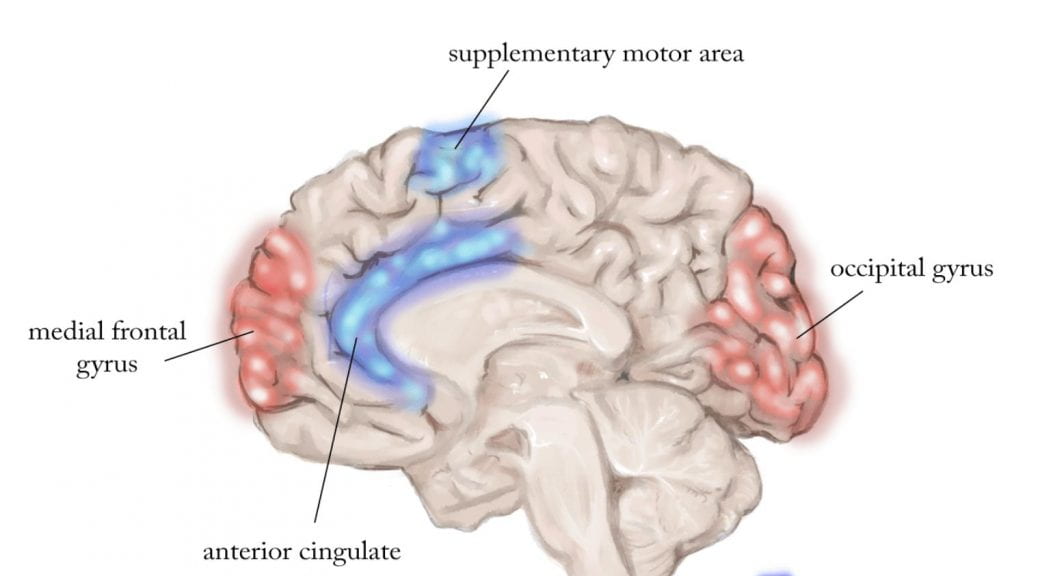
Scientific and Artistic Creativity Compared
By Sheridan Scott – Artwork by Sarrah Hussain – February 26, 2021
Have you ever wondered why people are creative in distinct and sometimes absurd ways? Creativity entails a wide array of original ideas: a local grocery store shopper who fastened pool noodles to his head to ensure other shoppers remained six feet away, a parent who “cleverly” grinds up spinach to put in brownies, or a friend who duct-tapes a bottle to his leg to avoid unnecessary breaks during Call of Duty. Creativity produces vast outcomes ranging from a fun new idea to a renowned work of art to a groundbreaking discovery. As a whole, it is inherent to the human experience, but ongoing research is still shedding light onto how creativity evolved and the neural mechanisms required within different types of creativity.
The origin of creativity was falsely believed to be around 40,000 years ago when Homo sapiens began decorating cave walls with elaborate paintings; however, archeologists have recently discovered creativity’s origin was before Homo sapiens evolved, over 200,000 years ago. Since its origin, scientists and scholars alike have struggled to define creativity and uncover its neural mechanisms. The difficulties within defining creativity and determining what neural networks contribute to creative thought overlap: creativity possesses several definitions, some more arbitrary than others; creativity is an integration of several cognitive processes; and there exists differing forms of creative thought, each relying upon unique neural pathways.
For the sake of this exploration into creativity, we will focus upon two key components of creative thought: an idea generation phase, involving the transfer of information between domains; and then an idea exploration phase, where conceptual limitations are considered. It is important to acknowledge that, while these mental operations are critical to creative thought, they are limited to the extent of their application. Under general conditions, creativity can be examined through analyzing three standard cognitive processes: conceptual expansion, creative imagery, and overcoming knowledge constraints. To illustrate this, contemplate new uses for a hat (pause for a moment to think of a few ideas). Other normative uses for a hat, such as carrying a wallet and keys, are less cognitively demanding to concoct than more novel uses for a hat. When contemplating more novel uses, you likely pictured a hat, considering its texture, size, shape, and volume (creative imagery). As you were contemplating this, you may have realized a hat could function as a hiding place for items such as money or concert tickets (conceptual expansion). However, while achieving conceptual expansion, you were probably forced to overcome knowledge constraints, attempting to avoid ideas you already considered.
Upon discussing and illustrating the two main components of creative thought, we will next delve into the neurological mechanisms at play within novel creative thought. Neural structures (inferior frontal, temporopolar, and frontopolar) involved in controlled semantic processing and integration are more activated during conceptual expansion compared to other methods of semantic thought. As for creative cognition, lesions of the frontal lobe, the brain region underlying cognitive control and cognitive disinhibition, and basal ganglia, the brain region underlying attention and inhibition, cause individuals to overcome knowledge constraints more easily than the control groups. The reason for this is people who are more prone to distractibility are more apt at inhibiting salient information, supporting previous findings that individuals with ADHD or Schizophrenia score higher in creativity.
Expanding within creativity’s neural mechanisms, we will lastly consider scientific and artistic creativity. These both rely upon cohesion between neural regions and networks involved in creative thought, but the mechanisms differ depending on what form of creative thought is occurring. For instance, consider the differing cognitive processes involved if you were designing an experiment for the science fair versus working on an art piece for an exhibit. The former involves a greater emphasis upon logic, reasoning, and analytic thought; whereas the latter involves manipulating a visual aesthetic and may draw upon the artist’s innermost emotions.
In a 400 person study published by Nature Research Journal, approximately 400 persons underwent a study that examined the differences occurring in the brain during either scientific or artistic creativity. The study’s methods entailed a Creative Achievement Questionnaire (CAQ), which consisted of 10 different creativity domains where study participants rated themselves in areas of both artistic (factor 1) and scientific (factor 2) creativity scores; a Combined Raven’s Test-Rural in China, used to measure general intelligence; and an Magnetic Resonance Imaging (MRI) to assess gray versus white matter among participants and cerebral spinal fluid. The study discovered that people who scored high within either artistic or scientific creativity had notable differences within their brains compared to those who scored lower, as seen from the differing levels of gray matter in the images below. Individuals who scored higher within scientific creativity had fMRI scans with more gray matter volume in brain regions (the medial frontal gyrus and occipital gyrus) that deal with semantic processing and reasoning, integrating semantic concepts into original ideas. People who scored higher within artistic creativity, on the other hand, had fMRI scans with less gray matter volume within brain regions (the anterior cingulate cortex and the supplementary motor area) that inhibit negative emotions and emotion derived creativity.
Depending upon several cognitive processes and neural mechanisms, creativity is a complex entity that paves the way for new ideas, innovations, and societal progress. As we continue to understand the inner workings of creative thought, we learn how to maximize upon our own creative potential and develop a greater understanding of humankind’s evolution.

